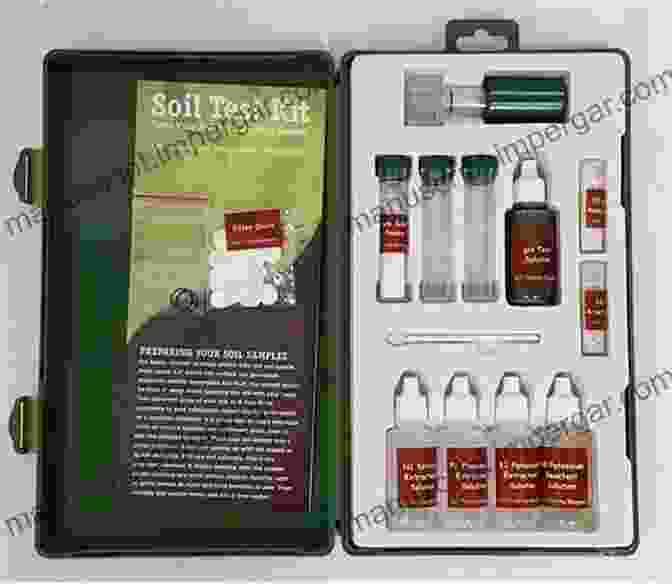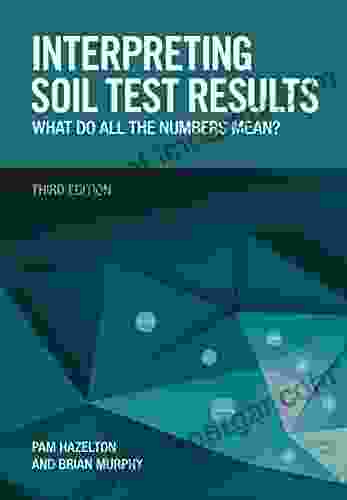Unlocking the Secrets of Your Soil: A Comprehensive Guide to Interpreting Soil Test Results


Every gardener, farmer, and homeowner dreams of having a lush, thriving landscape. But achieving this dream requires more than just planting seeds and watering them. Soil is the foundation of all plant life, and understanding its composition is crucial for successful gardening and farming. A soil test provides valuable insights into your soil's health and fertility, guiding you in making informed decisions about amendments and fertilizer applications.
Understanding Soil Test Results
A soil test report is a comprehensive analysis of your soil's chemical and physical properties. It typically includes the following measurements:
5 out of 5
| Language | : | English |
| File size | : | 2434 KB |
| Text-to-Speech | : | Enabled |
| Screen Reader | : | Supported |
| Enhanced typesetting | : | Enabled |
| Word Wise | : | Enabled |
| Print length | : | 200 pages |
1. pH Level
Soil pH measures the acidity or alkalinity of your soil on a scale of 0 to 14. Most plants prefer a pH range between 6.0 and 7.0, which is slightly acidic to neutral. If your soil's pH is too low (acidic) or too high (alkaline),it can affect nutrient availability and plant growth.
2. Nutrient Levels
Soil tests measure the levels of essential nutrients, including nitrogen (N),phosphorus (P),potassium (K),calcium (Ca),magnesium (Mg),and sulfur (S). These nutrients are vital for plant growth and development. Optimal nutrient levels vary depending on the plant species and soil conditions.
3. Organic Matter Content
Organic matter in the soil influences its fertility, water-holding capacity, and aeration. Soil tests determine the percentage of organic matter present, which is an indicator of soil health. Higher organic matter content improves soil quality and supports healthy plant growth.
4. Texture Analysis
Soil texture refers to the relative proportions of sand, silt, and clay in the soil. This information helps determine the soil's drainage, water-holding capacity, and nutrient retention abilities. Understanding soil texture is crucial for selecting suitable plants and irrigation practices.
5. Salinity and Soluble Salts
Excessive salts in the soil can inhibit plant growth and reduce crop yields. A soil test measures the levels of soluble salts and electrical conductivity to assess soil salinity. High salt levels may require special management practices, such as leaching or drainage improvements.
Interpreting Your Soil Test Results
Once you have your soil test results, the next step is to interpret them correctly. Here are some guidelines to help you understand what the numbers mean:
1. pH Level
* Most plants prefer a pH range between 6.0 and 7.0. * Acidic soils (pH below 6.0) can cause nutrient deficiencies, especially phosphorus and molybdenum. * Alkaline soils (pH above 7.0) can reduce the availability of iron, manganese, and zinc.
2. Nutrient Levels
* Optimal nutrient levels vary depending on the plant species and soil conditions. * Low nutrient levels may indicate the need for fertilizer applications. * High nutrient levels can be harmful to plants and may require additional soil testing to determine the source of the excess nutrients.
3. Organic Matter Content
* Aim for an organic matter content of at least 3-5%. * Higher organic matter levels improve soil structure, water-holding capacity, and fertility. * Consider adding compost or other organic materials to increase organic matter content.
4. Texture Analysis
* Sandy soils: Drain well but have low water-holding capacity and nutrient retention. * Silty soils: Have good water-holding capacity but can be prone to compaction. * Clay soils: Have high water-holding capacity and nutrient retention but can be difficult to work with.
5. Salinity and Soluble Salts
* High salt levels can inhibit plant growth and reduce crop yields. * If salt levels are high, consider leaching the soil with water, installing a drainage system, or using salt-tolerant plant species.
Amending Your Soil Based on Test Results
Once you have interpreted your soil test results, you can make informed decisions about amending your soil to improve its fertility and support healthy plant growth. Here are some guidelines:
1. Adjusting pH Level
* To raise soil pH: Add lime or wood ashes. * To lower soil pH: Add sulfur, aluminum sulfate, or iron sulfate.
2. Adding Nutrients
* Choose a fertilizer that provides the nutrients your soil needs. * Follow the fertilizer application instructions carefully to avoid over-fertilizing.
3. Increasing Organic Matter
* Add compost, manure, or other organic materials to increase organic matter content. * Incorporate organic matter into the soil to improve soil structure and fertility.
4. Improving Texture
* Sandy soils: Add organic matter to improve water-holding capacity and nutrient retention. * Silty soils: Aerate the soil to improve drainage and prevent compaction. * Clay soils: Add sand or organic matter to improve soil texture and drainage.
Interpreting soil test results is a valuable tool for gardeners, farmers, and homeowners. By understanding your soil's composition, you can make informed decisions about amendments and fertilizer applications, creating a thriving environment for your plants. Remember, healthy soil leads to healthy plants, abundant harvests, and a beautiful landscape that you can enjoy for years to come.
5 out of 5
| Language | : | English |
| File size | : | 2434 KB |
| Text-to-Speech | : | Enabled |
| Screen Reader | : | Supported |
| Enhanced typesetting | : | Enabled |
| Word Wise | : | Enabled |
| Print length | : | 200 pages |
Do you want to contribute by writing guest posts on this blog?
Please contact us and send us a resume of previous articles that you have written.
 Book
Book Novel
Novel Page
Page Chapter
Chapter Text
Text Story
Story Genre
Genre Reader
Reader Library
Library Paperback
Paperback E-book
E-book Magazine
Magazine Newspaper
Newspaper Paragraph
Paragraph Sentence
Sentence Bookmark
Bookmark Shelf
Shelf Glossary
Glossary Bibliography
Bibliography Foreword
Foreword Preface
Preface Synopsis
Synopsis Annotation
Annotation Footnote
Footnote Manuscript
Manuscript Scroll
Scroll Codex
Codex Tome
Tome Bestseller
Bestseller Classics
Classics Library card
Library card Narrative
Narrative Biography
Biography Autobiography
Autobiography Memoir
Memoir Reference
Reference Encyclopedia
Encyclopedia Charles Wilhelm
Charles Wilhelm Wolfgang Daunicht
Wolfgang Daunicht Chris Forhan
Chris Forhan M S Woodley
M S Woodley Michael Pillsbury
Michael Pillsbury Will Bagley
Will Bagley Christian Joppke
Christian Joppke Chizzy Ndukwe N
Chizzy Ndukwe N Jackie Spinner
Jackie Spinner William Beausay
William Beausay Rachel Knowles
Rachel Knowles Stan Kowalski Phd
Stan Kowalski Phd Charles R Morris
Charles R Morris Christopher Wall
Christopher Wall Chloe Martis
Chloe Martis Nickolas Pappas
Nickolas Pappas Chris Whipple
Chris Whipple David Holub
David Holub Myles Dungan
Myles Dungan Charles Walters
Charles Walters
Light bulbAdvertise smarter! Our strategic ad space ensures maximum exposure. Reserve your spot today!

 John SteinbeckUnveiling the Extraordinary Life of Susan Reynolds: A Journey of Adventure,...
John SteinbeckUnveiling the Extraordinary Life of Susan Reynolds: A Journey of Adventure,...
 Norman ButlerMissions, States, and European Expansion in Africa: Uncovering the Hidden...
Norman ButlerMissions, States, and European Expansion in Africa: Uncovering the Hidden...
 Robert FrostGreenhouse Technology and Management: The Ultimate Guide to Maximizing Plant...
Robert FrostGreenhouse Technology and Management: The Ultimate Guide to Maximizing Plant...
 Bernard PowellThe Fabulous Zed Watson: A Literary Masterpiece that Transcends the Ordinary
Bernard PowellThe Fabulous Zed Watson: A Literary Masterpiece that Transcends the Ordinary
 William PowellUnlock the World of International Commerce with "International Commercial...
William PowellUnlock the World of International Commerce with "International Commercial... Terence NelsonFollow ·7.2k
Terence NelsonFollow ·7.2k Gary ReedFollow ·3.1k
Gary ReedFollow ·3.1k Francisco CoxFollow ·8.4k
Francisco CoxFollow ·8.4k E.E. CummingsFollow ·4.1k
E.E. CummingsFollow ·4.1k Zachary CoxFollow ·18.2k
Zachary CoxFollow ·18.2k Darius CoxFollow ·16.9k
Darius CoxFollow ·16.9k Rodney ParkerFollow ·18.5k
Rodney ParkerFollow ·18.5k Paulo CoelhoFollow ·17.9k
Paulo CoelhoFollow ·17.9k

 E.E. Cummings
E.E. CummingsOne Man's Story of What It Meant to be Pj
In the tapestry of life,...

 Caleb Long
Caleb LongPattern Theory in Video Keno: Unveiling the Art of...
Embark on an enlightening journey into the...

 Douglas Adams
Douglas AdamsUnveiling the Diplomatic Landscape: The Ottoman Empire,...
Delving into the History...

 Terry Bell
Terry BellThere Still Is No Off Season: Embracing Year-Round...
In a world consumed by routine and the allure...

 Ibrahim Blair
Ibrahim BlairBrain Teasers Games and Puzzles: Exercise Your Mind with...
Prepare to embark on a captivating journey...
5 out of 5
| Language | : | English |
| File size | : | 2434 KB |
| Text-to-Speech | : | Enabled |
| Screen Reader | : | Supported |
| Enhanced typesetting | : | Enabled |
| Word Wise | : | Enabled |
| Print length | : | 200 pages |




